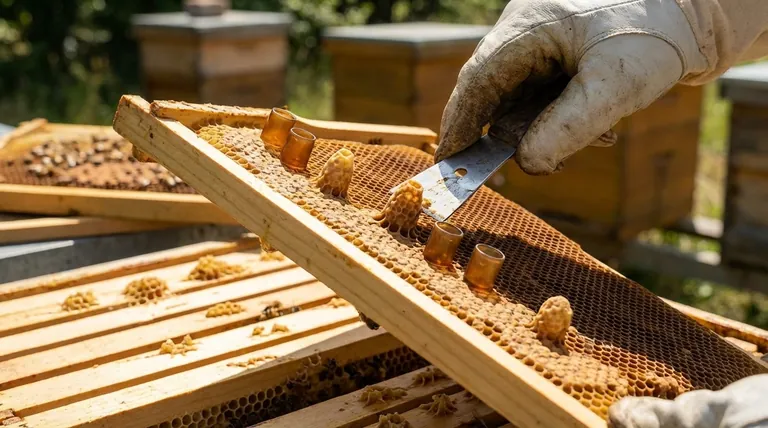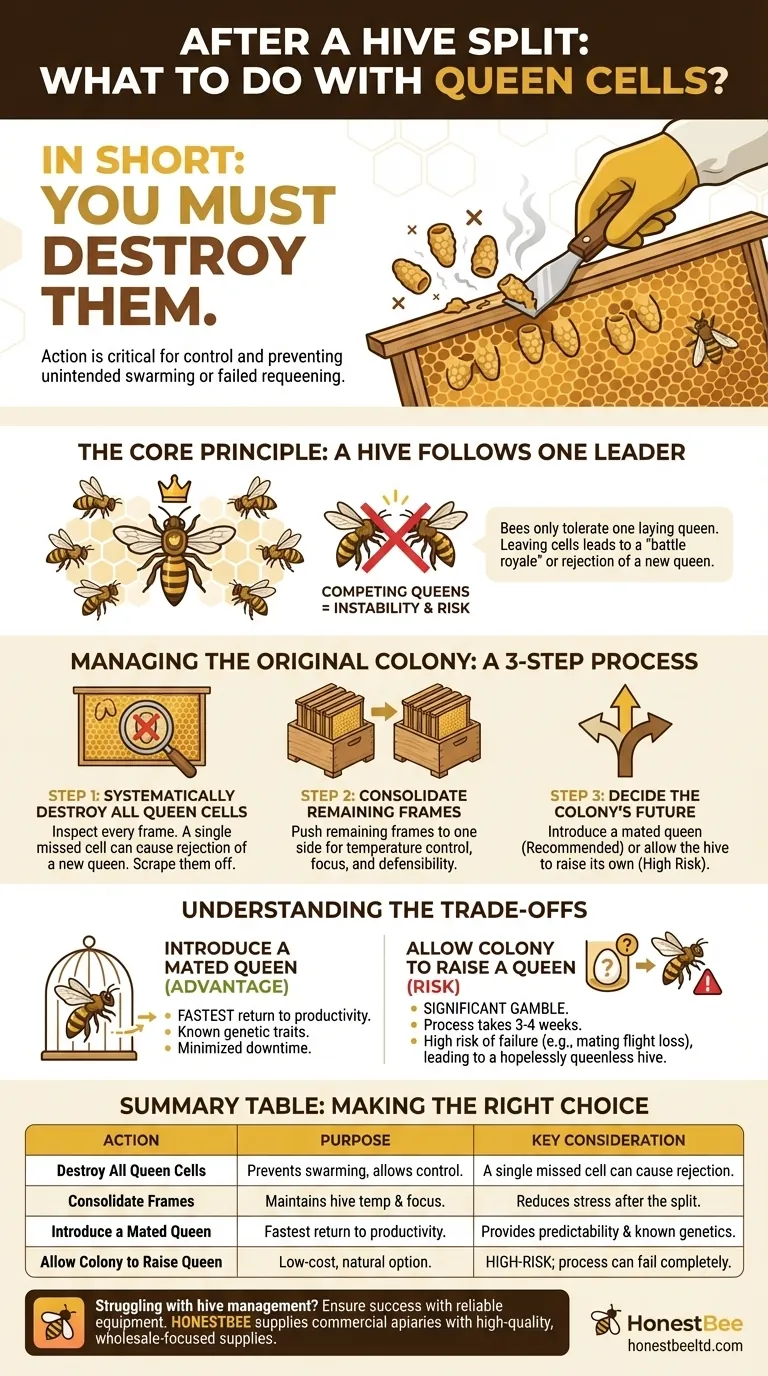In short, you must destroy them. After removing frames to create a nucleus colony (a "nuc"), any and all queen cells left behind in the original, full-size hive must be systematically removed. This action is critical for maintaining control over the colony's future and preventing unintended swarming or a failed requeening.
The presence of queen cells in the original hive is a signal that the bees are preparing to replace their monarch. Leaving them undermines your management strategy, forcing the colony down a path of uncertainty that can lead to swarming or a long, unproductive period without a laying queen.
The Core Principle: A Hive Follows One Leader
To understand why removing these cells is non-negotiable, you must first understand the rigid social structure of a honey bee colony.
Why Bees Create Queen Cells
When a colony becomes queenless, or when it grows large enough to prepare for swarming, the worker bees initiate an emergency response. They select several young larvae and begin feeding them a special diet of royal jelly, constructing the characteristic large, peanut-shaped queen cells around them.
This is the colony's natural succession plan. Your act of removing frames to create a nuc, especially if you included the original queen in that nuc, makes the parent hive instantly queenless and triggers this very response.
The Problem with Competing Queens
A honey bee colony will only tolerate one laying queen. If you leave the remaining queen cells in the parent hive and also attempt to introduce a new, mated queen, the workers will almost certainly kill the queen you introduce. They will favor the queens they are raising themselves.
Even if you don't introduce a new queen, leaving multiple queen cells creates a "battle royale." The first virgin queen to emerge will proceed to sting and kill her unborn sisters while they are still in their cells. If two emerge at once, they will fight to the death, and the colony's stability hangs in the balance.
Managing the Original Colony After a Split
Once you have removed frames for your nuc, your focus must shift to stabilizing the original hive. This involves a clear, three-step process.
Step 1: Systematically Destroy All Queen Cells
This is the most critical step. You must inspect every remaining frame in the original hive with extreme care. Queen cells can be hidden in crevices or along the bottom of frames.
A single missed cell is all it takes for the bees to reject a new queen you introduce. Scrape off any you find to ensure the colony is truly "reset" and ready to accept the queen you choose for them.
Step 2: Consolidate the Remaining Frames
With several frames removed, there will be empty space in the hive body. Push all the remaining frames together to one side of the box.
This consolidation helps the colony maintain proper temperature and humidity. It also focuses their efforts on a smaller area, improving their efficiency and defensibility.
Step 3: Decide the Colony's Future
You now have a queenless colony that is primed for a new leader. You must decide whether you will introduce a new, mated queen or allow the hive to try and raise its own from a frame of eggs you provide. For most management goals, introducing a queen is the superior path.
Understanding the Trade-offs
The decision to destroy all queen cells is a decision to take control. Allowing nature to take its course is an option, but one fraught with risk.
The Advantage of Requeening
Introducing a new, mated queen is the fastest and most reliable way to return the colony to productivity. A purchased queen often has known genetic traits (such as gentleness or mite resistance), and because she is already mated, she can begin laying eggs within days of being accepted. This minimizes the downtime for the colony.
The Risk of Leaving Queen Cells
If you were to leave a queen cell (or provide a frame with fresh eggs) and let the colony raise its own queen, you are taking a significant gamble.
The new virgin queen must emerge, kill her rivals, mature, and then fly out on one or more mating flights. During these flights, she can be eaten by a bird, get lost, or fail to mate successfully. If she does not return, the colony becomes hopelessly queenless and will perish without further intervention. This entire process can take three to four weeks, during which no new eggs are being laid.
Making the Right Choice for Your Goal
Your actions should be guided by your primary objective for the colony.
- If your primary focus is control, predictability, and a rapid return to production: Destroy all remaining queen cells and introduce a new, mated queen into the original hive.
- If your primary focus is creating a strong nuc from a swarming hive: Move the frame(s) with the best-looking queen cells into the nuc, and destroy all cells left in the parent hive to prevent it from swarming (assuming the old queen is still there).
- If you are an experienced beekeeper willing to accept risk for a "free" queen: You could leave one or two promising queen cells, but be prepared for potential failure and the need to intervene again in several weeks.
Decisive action is the foundation of successful beekeeping; clearing these queen cells is your most important move.

Summary Table:
| Action | Purpose | Key Consideration |
|---|---|---|
| Destroy All Queen Cells | Prevents unintended swarming and allows for controlled requeening. | A single missed cell can cause the colony to reject a new queen. |
| Consolidate Remaining Frames | Helps the colony maintain temperature and focus its efforts. | Reduces stress on the bees after the split. |
| Introduce a Mated Queen | Fastest way to return the colony to egg-laying productivity. | Provides predictability and known genetic traits. |
| Allow Colony to Raise a Queen | A low-cost, natural option. | High-risk; process can fail, leaving the colony hopelessly queenless. |
Struggling with hive management after a split? Ensure your apiary's success with reliable equipment and expert support. HONESTBEE supplies commercial apiaries and beekeeping equipment distributors with the high-quality, wholesale-focused supplies needed for precise colony control. Contact our team today to discuss your needs and keep your operations productive.
Visual Guide

Related Products
- Brown Nicot Queen Cell Cups for Breeding Queen Bees Beekeeping
- JZBZ Langstroth Queen Rearing Frame for Beekeeping
- JZBZ Push-In Queen Cell Cups for Beekeeping
- JZBZ Type Wide Base Plastic Queen Cell Cups for Base Mounting and Queen Rearing
- Clear Black Plain Polystyrene Queen Bee Grafting Cell Cups No Lug for Bee Queen Cup
People Also Ask
- What are the ideal conditions for raising good queen cells? Achieve Robust Queens with Strong Cell-Builder Colonies
- What is the benefit of inducing supersedure by giving a queenright colony a protected queen cell? A Seamless Requeening Method
- What role does the natural swarming process play in queen rearing? Harness the Swarm Instinct for Better Queens
- What should be done with extra queens from grafting? A Strategic Guide for Apiary Management
- How many cells are given to a nucleus? Understand the One-to-One Rule in Cell Biology













